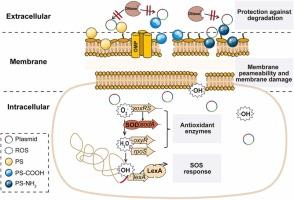Surface-modified nanoplastics facilitate the dissemination and persistence of antibiotic resistance genes
IF 11.3
1区 环境科学与生态学
Q1 ENGINEERING, ENVIRONMENTAL
引用次数: 0
Abstract
Plastic pollution and antibiotic resistance are emerging environmental crises, which pose threat to human and ecology health. Although micro/nano plastics have been found to exacerbate antibiotic resistance genes (ARGs) dissemination, the impacts of differentially surface-modified nanoplastics on ARGs transformation remains unclear. In this study, transformation experiments were performed to elucidate the impacts of surface-modified polystyrene (PS) nanoplastics on ARGs transformation. Compared with pristine PS nanoplastics, carboxyl- and amino-modified PS nanoplastics (10 mg/L and 100 mg/L) significantly facilitate the ARG transformation frequency and efficiency. The direct mechanisms were attributed to alternations in cell membrane, including increased cell membrane permeability and pore formation on cell membrane, as well as overproduction of reactive oxygen species, which consequently induced the SOS response. And this was verified by the varied expression levels of related functional genes. Additionally, nanoplastics could inhibit the enzymatic degradation of plasmids, potentially contributing to the persistence of ARGs in environments. These findings suggests that the ecological risks associated with nanoplastics in promoting ARGs dissemination should not be overlooked, since the co-occurrence of ARGs and plastics is pervasive and persistent in diverse habitats.

表面修饰的纳米塑料促进了抗生素耐药基因的传播和持久性
塑料污染和抗生素耐药性是新出现的环境危机,对人类和生态健康构成威胁。虽然微纳米塑料已被发现会加剧抗生素耐药基因(ARGs)的传播,但不同表面改性纳米塑料对ARGs转化的影响尚不清楚。本研究通过转化实验研究了表面改性聚苯乙烯(PS)纳米塑料对ARGs转化的影响。与原始PS纳米塑料相比,羧基改性和氨基改性PS纳米塑料(10 mg/L和100 mg/L)显著提高了ARG转化的频率和效率。直接机制归因于细胞膜的改变,包括细胞膜通透性的增加和细胞膜上孔的形成,以及活性氧的过量产生,从而诱导了SOS反应。相关功能基因的不同表达水平证实了这一点。此外,纳米塑料可以抑制质粒的酶降解,可能有助于ARGs在环境中的持久性。这些发现表明,纳米塑料在促进ARGs传播方面的生态风险不应被忽视,因为ARGs和塑料的共存在不同的栖息地是普遍和持续的。
本文章由计算机程序翻译,如有差异,请以英文原文为准。
求助全文
约1分钟内获得全文
求助全文
来源期刊

Journal of Hazardous Materials
工程技术-工程:环境
CiteScore
25.40
自引率
5.90%
发文量
3059
审稿时长
58 days
期刊介绍:
The Journal of Hazardous Materials serves as a global platform for promoting cutting-edge research in the field of Environmental Science and Engineering. Our publication features a wide range of articles, including full-length research papers, review articles, and perspectives, with the aim of enhancing our understanding of the dangers and risks associated with various materials concerning public health and the environment. It is important to note that the term "environmental contaminants" refers specifically to substances that pose hazardous effects through contamination, while excluding those that do not have such impacts on the environment or human health. Moreover, we emphasize the distinction between wastes and hazardous materials in order to provide further clarity on the scope of the journal. We have a keen interest in exploring specific compounds and microbial agents that have adverse effects on the environment.
 求助内容:
求助内容: 应助结果提醒方式:
应助结果提醒方式:


